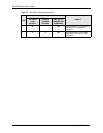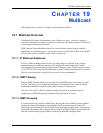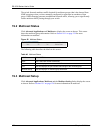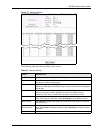
ES-2024 Series User’s Guide
Chapter 18 Queuing Method 122
CHAPTER 18
Queuing Method
This chapter introduces the queuing methods supported.
18.1 Queuing Method Overview
Queuing is used to help solve performance degradation when there is network congestion. Use
the Queuing Method screen to configure queuing algorithms for outgoing traffic. See also
Priority Queue Assignment in Switch Setup and 802.1p Priority in Port Setup for related
information.
Queuing algorithms allow switches to maintain separate queues for packets from each
individual source or flow and prevent a source from monopolizing the bandwidth.
18.1.1 Strict Priority Queuing (SPQ)
Strict Priority Queuing (SPQ) services queues based on priority only. As traffic comes into the
switch, traffic on the highest priority queue, Q3 is transmitted first. When that queue empties,
traffic on the next highest-priority queue, Q2 is transmitted until Q2 empties, and then traffic is
transmitted on Q1 and so on. If higher priority queues never empty, then traffic on lower
priority queues never gets sent. SPQ does not automatically adapt to changing network
requirements.
18.1.2 Weighted Round Robin Scheduling (WRR)
Round Robin Scheduling services queues on a rotating basis and is activated only when a port
has more traffic than it can handle. A queue is a given an amount of bandwidth irrespective of
the incoming traffic on that port. This queue then moves to the back of the list. The next queue
is given an equal amount of bandwidth, and then moves to the end of the list; and so on,
depending on the number of queues being used. This works in a looping fashion until a queue
is empty.
Table 38 Physical Queue Priority
QUEUE PRIORITY
Q3 4 (highest)
Q2 3
Q1 2
Q0 1 (lowest)


















